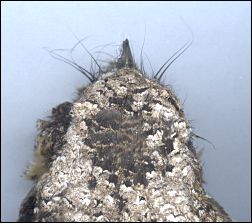

Hair is one feature of mammals shared by no other group of living animals. All mammals—even whales—have at least a few shafts of hair sometime during their life. Some people get a bit confused by this claim, though, remembering hairs on the carcass of a plucked hen, the whiskers on the face of many birds, or even the hairy covering of a kiwi. This falls into the realm of things aren't always as they seem. Lots of things that look the same superficially, turn out to be quite different when examined in detail.
Often, this is a result of convergent evolution. Some structures are so
useful that they've been stumbled on evolutionarily by various groups through
different pathways. Detailed investigation of the hairs of chickens or the whiskers of
our desert nighthawks show that these really are feathers--but feathers so modified
that they function like hairs. While biologists find it imperative to separate
convergences from true relationships, entrepreneurs often ignore such. Which is why you
may buy a euphorbia advertised as a cactus.

Contributor: Arthur H. Harris, Laboratory for Environmental Biology, Centennial Museum, University of Texas at El Paso.
Desert Diary is a joint production of the Centennial Museum and KTEP National Public Radio at the University of Texas at El Paso.

Hair-like feathers of a caprimulgid bird. These birds feed on the wing, the feathers helping to scoop insects into the large mouth. Scanned image.
Feldhamer, G. A., L. C. Drickamer, S. H. Vessey, and J. F. Merritt. 1999. Mammalogy. McGraw-Hill, Boston. 563 pp.